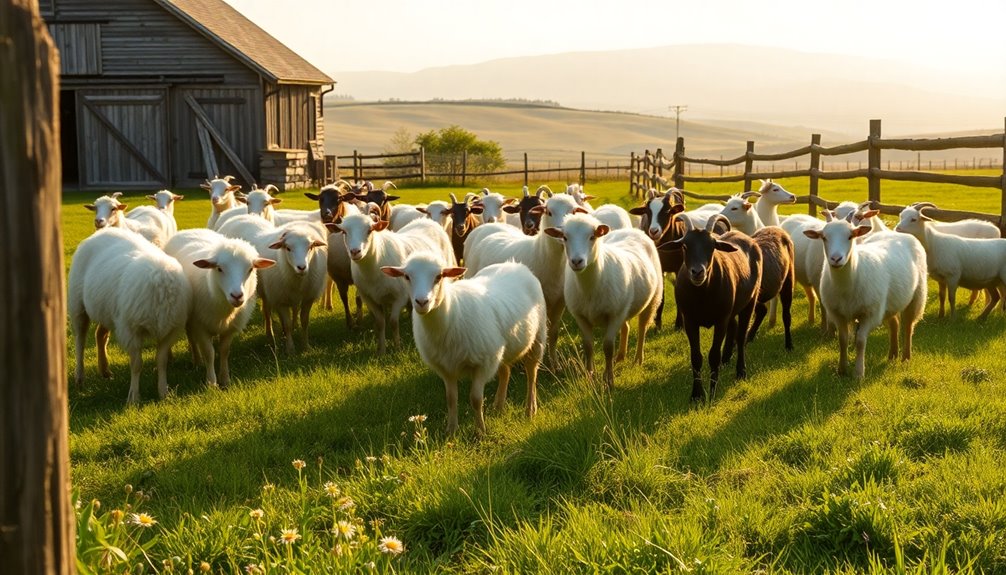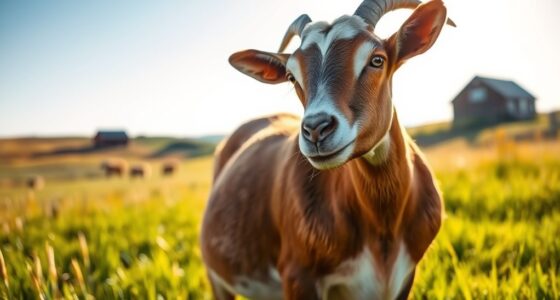Yes, you can successfully keep sheep and goats together with the right management. Since they have different dietary needs, make sure to provide separate mineral supplements to avoid copper toxicity in sheep. Keep an eye on their health to prevent disease transmission, and create a safe environment with sturdy fencing. Behavioral compatibility often enhances herd dynamics, so observe their interactions closely. Gradually introduce new animals to reduce aggressive behavior. With careful planning, both species can thrive harmoniously. Explore further to discover additional insights on maintaining a mixed herd effectively.
Key Takeaways
- Sheep and goats can cohabitate if dietary needs are met through separate mineral supplements and grazing areas to prevent resource competition.
- Implement gradual introductions and monitor herd dynamics to ensure social harmony and reduce aggressive behavior during cohabitation.
- Use sturdy fencing, such as woven wire or stock fencing, to contain goats and prevent them from escaping or intruding on sheep areas.
- Regular health checks and quarantining new animals are vital to prevent disease transmission between the two species.
- Engage in enrichment activities and observe individual personalities to enhance well-being and mitigate stress within the mixed herd.
Understanding Species Differences
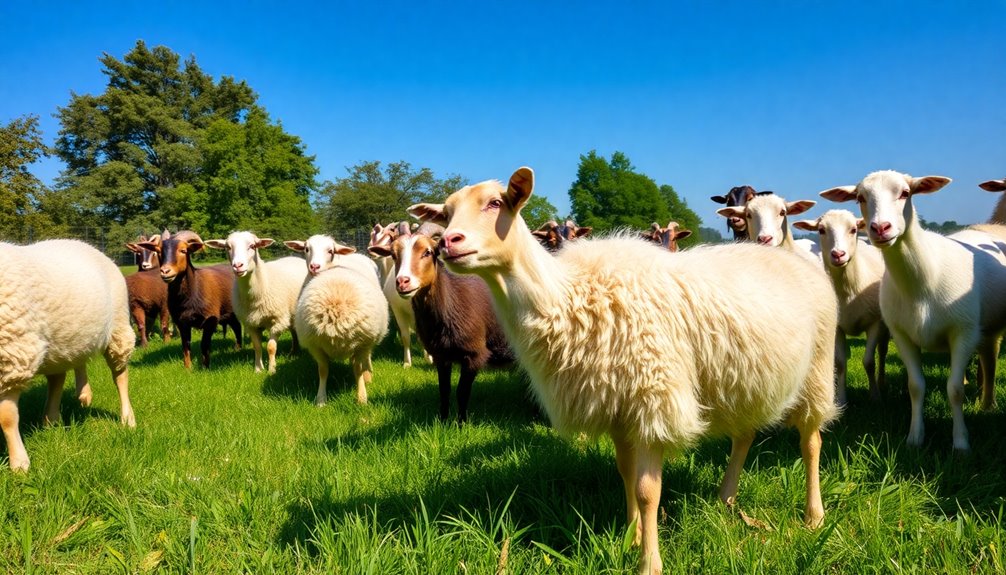
When considering a mixed herd, it's important to understand the fundamental differences between sheep and goats. These two species have unique dietary preferences that can lead to competition for food.
Sheep are grazers, primarily consuming grass with their heads down, while goats need to browse on woody plants, shrubs, and tree leaves. If you're keeping sheep and goats together, you'll need to guarantee that both have access to their preferred foods.
Another key difference is their dietary requirements. Goats need higher levels of copper, but sheep are sensitive to copper and can suffer toxicity if their intake exceeds 40 PPM.
Regular health checks are necessary; goats may show signs of copper deficiency through their fur quality, while sheep need monitoring for parasites and overall body condition.
Social behaviors also differ—goats tend to be more adventurous, often climbing, while sheep are more docile. You'll need to carefully observe their interactions to prevent conflicts.
Additionally, effective fencing is essential. While sheep are generally easier to contain, goats require sturdy fencing to prevent escapes due to their climbing nature.
Understanding these differences is fundamental for a harmonious mixed herd.
Health Management and Disease Risks
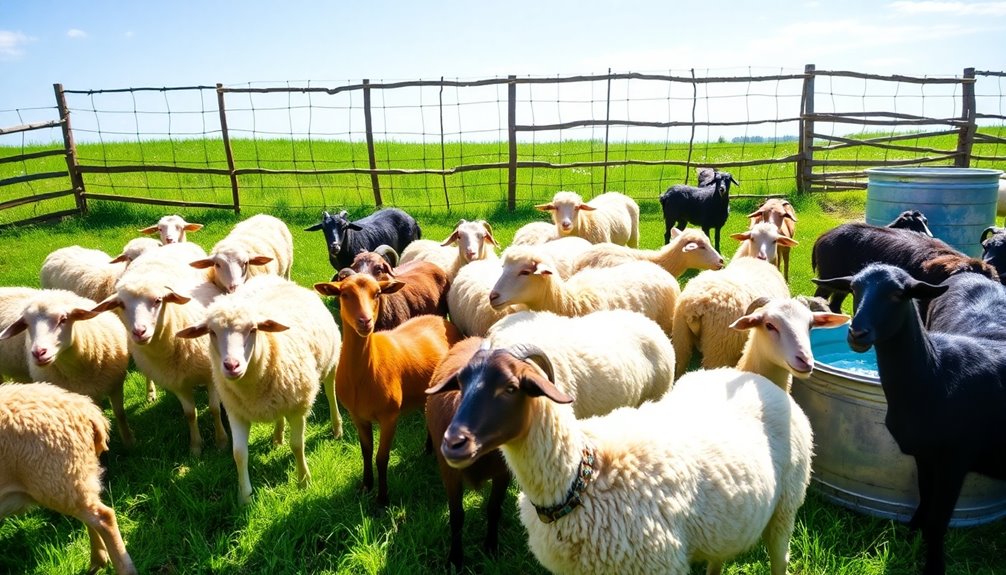
When you mix sheep and goats, you need to be aware of the potential for disease transmission, as they can share illnesses like CAE and OPP.
It's important to quarantine new animals for at least 30 days and keep a close eye on your herd's health.
Regular monitoring and tailored parasite management are key to keeping both species healthy together.
Disease Transmission Risks
Managing disease transmission in mixed herds of sheep and goats is vital for maintaining their health. Both species can share diseases like Caprine Arthritis Encephalitis (CAE) and Ovine Progressive Pneumonia (OPP), so effective disease management strategies are essential.
Start by quarantining new animals for at least two weeks. This allows you to monitor them for any signs of illness before they join your existing herd.
Regular parasite monitoring is also key. Some parasites are species-specific, and keeping an eye on parasite loads helps you prevent outbreaks that could affect both sheep and goats.
Implementing a robust vaccination protocol tailored to each species' specific needs guarantees that your herd stays protected against prevalent diseases.
Additionally, purchasing animals from disease-free breeders reduces the risk of introducing contagious diseases into your mixed herd. This proactive approach not only safeguards the health of your flock but also promotes better overall health outcomes for all animals involved.
Quarantine and Monitoring Practices
Quarantine and monitoring practices are key components in maintaining the health of mixed herds. When you introduce new sheep into your existing flock, it's vital to quarantine them for at least 30 days. This period allows you to closely monitor for any signs of illness and helps prevent disease transmission, particularly diseases like Caprine Arthritis Encephalitis (CAE) and Ovine Progressive Pneumonia (OPP), which can easily spread between sheep and goats.
Regular health monitoring should become part of your routine. Conduct parasite management practices, including drenching and regular fecal checks, to keep internal parasites at bay. Purchasing animals from disease-free breeders greatly reduces the risk of introducing infections to your herd.
Additionally, don't overlook vaccination and preventive care. Regular veterinary consultations will help you stay on top of health risks and maintain overall well-being in your mixed herd.
Nutritional Needs and Mineral Balance
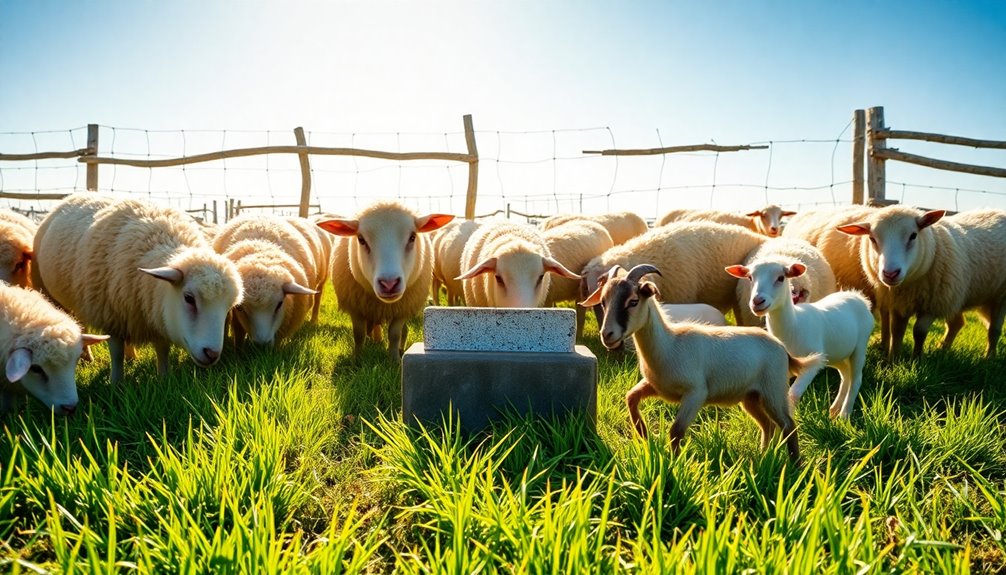
Understanding the nutritional needs and mineral balance for mixed herds of sheep and goats is vital for their health and well-being. Sheep require less copper than goats, so managing their diets is important to prevent copper toxicosis. If sheep consume goat feed that's too high in copper, it can lead to serious health issues.
Conversely, copper deficiency in goats can be fatal if left unaddressed, emphasizing the significance of proper mineral management.
To meet the distinct dietary requirements of both species, consider offering separate mineral supplements. While free-choice minerals can be beneficial, you may need to monitor their intake closely to avoid health problems.
Joint mineral supplements are available, but confirm these meet both sheep and goats' specific needs for a healthy mineral balance.
Regularly assess and adjust feeding practices, especially during late pregnancy and early lactation for sheep. This helps assure they receive the right nutrition without adverse effects from goat feed.
Behavioral Interactions and Herd Dynamics
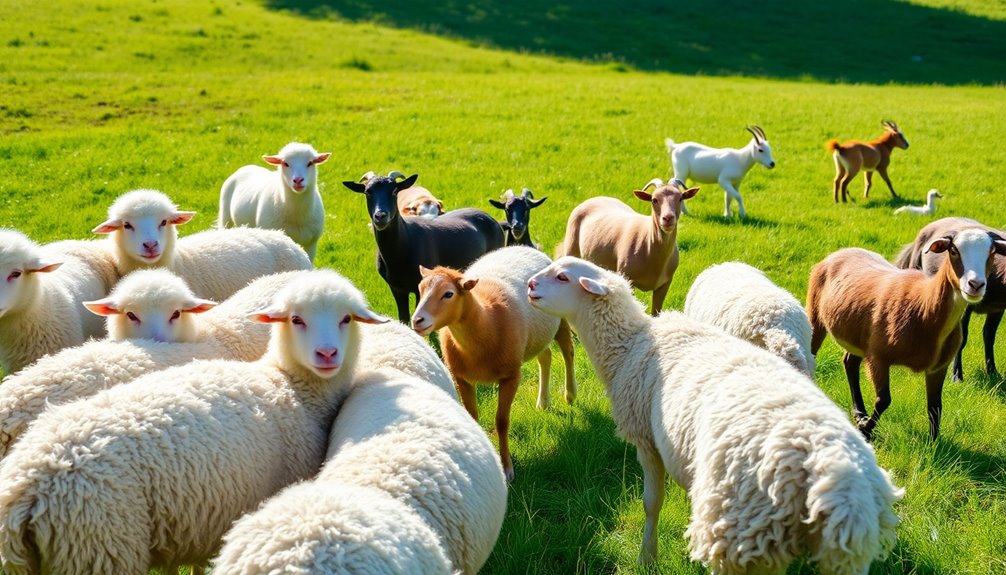
When you raise sheep and goats together, you'll likely notice strong social bonds forming between the species, enhancing their overall well-being.
However, managing aggressive behavior, especially from goats or rams during specific times, is essential to maintaining harmony in your herd.
Keeping a close eye on their interactions will help you understand the dynamics at play and guarantee a peaceful coexistence.
Social Bonding Between Species
Sheep and goats often form strong social bonds that enhance the overall dynamics of a mixed herd. When you raise sheep and goats together, you'll notice their interactions foster companionship, which is vital for a thriving environment.
Here are some key aspects to take into account:
- Goats can exhibit bossy behavior, particularly around humans, influencing the social dynamics.
- Playful interactions between goats and lambs highlight the significance of monitoring behavioral compatibility.
- Goats show protective instincts towards young lambs, creating beneficial interspecies relationships.
Regular observation of their interactions is important for understanding the social dynamics at play. Each animal has its own temperament, and recognizing these differences can help prevent conflicts.
While goats might take the lead in a mixed herd, their protective nature towards lambs can create a nurturing atmosphere. Just remember, it's important to keep an eye on how they interact, ensuring a harmonious balance in your mixed herd.
Aggressive Behavior Management
Aggressive behavior management is essential for maintaining harmony in a mixed herd of sheep and goats. Goats can sometimes exhibit bossy behavior, especially around humans, which may stress the flock if left unchecked.
To prevent conflicts, you need to closely monitor interactions between sheep and goats. Pay attention to how they interact during feeding or when they're playing. While playful interactions can strengthen bonds, aggressive behaviors can disrupt the herd's dynamics.
Rams can also display aggressive behavior, particularly when ewes are in heat. During breeding season, careful observation is important to avoid conflicts.
If you're introducing new animals to your herd, remember that the social structure may shift, so gradual introductions and monitoring are key to ensuring compatibility.
Providing adequate space and resources, such as food and water, is essential to minimize competition and aggression. When animals have enough room and resources, they're less likely to feel threatened or become aggressive towards each other.
Observing Herd Dynamics
Observing herd dynamics is vital for understanding how sheep and goats interact within a mixed environment. You'll find that individual personalities greatly influence their relationships, which can lead to both strong bonds and potential conflicts.
To maintain a harmonious herd, keep an eye on these key aspects:
- Bossy Goats: Goats may exhibit aggressive behaviors, especially towards sheep when humans are present.
- Playful Interactions: Goats and lambs often engage in playful behaviors, which can strengthen their social bonds.
- Breeding Season Caution: Rams can become aggressive during breeding seasons, requiring careful monitoring.
Regularly monitoring interactions within the herd is important. You want to spot any signs of stress or aggression before they escalate into serious conflicts.
Not only does this help you guarantee the well-being of both species, but it also fosters a more peaceful environment.
Safe Cohabitation Practices
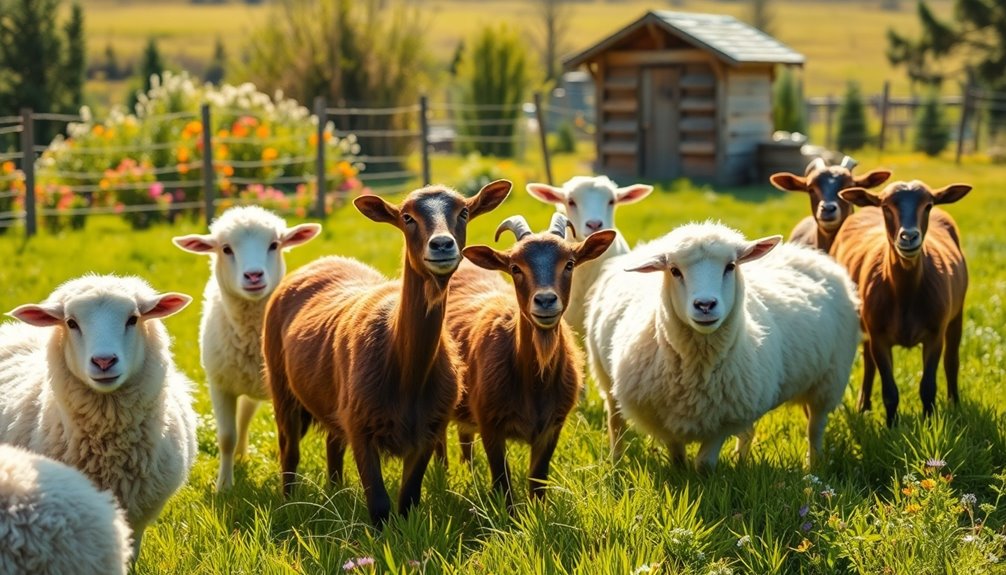
When considering the cohabitation of sheep and goats, it's essential to evaluate the compatibility of their breeds beforehand. Some breeds may get along better than others, so do your research to guarantee a harmonious environment.
To keep sheep and goats together effectively, provide ample space for both species. Overcrowding can lead to competition and aggression, which you'll want to avoid.
Regularly monitor the health and behavior of both species. Differences in social dynamics can arise, especially when introducing new animals. Make sure each group has access to their specific dietary needs, setting up separate feeding areas to minimize competition and prevent health issues.
Implement gradual introductions between new and existing sheep or goats. This allows them to acclimatize to one another, reducing the likelihood of aggressive encounters.
Breeding Considerations and Challenges
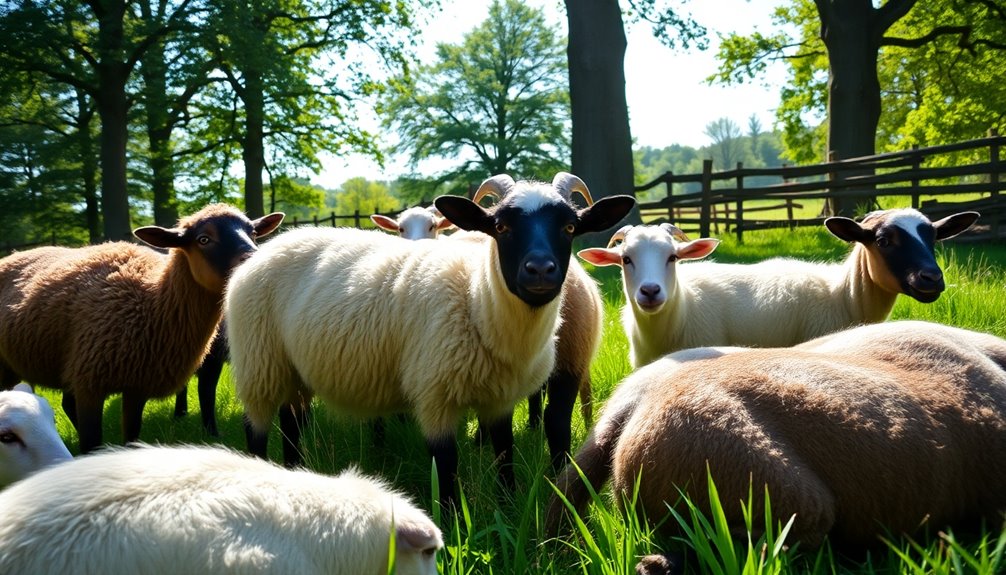
When managing breeding in a mixed herd, you need to contemplate genetic compatibility and health monitoring closely.
Introducing a buck requires careful timing and observation to prevent issues like miscarriages.
Breeding Season Management
Successfully managing the breeding season for mixed herds of sheep and goats requires careful planning and attention to detail. During this time, you'll need to take into account the unique behaviors of both species.
Keep in mind the following key points:
- Separate rams and ewes outside of breeding time to prevent stress and unwanted pregnancies.
- Monitor ewes closely, as specific breeds like Katahdins may come into heat year-round.
- Ascertain overall herd health to help ewes exhibit signs of heat effectively.
When introducing rams to ewes, be prepared for hormonal behaviors that can lead to aggression. Keeping rams separate until breeding season not only helps control timing but also reduces stress among the flock.
During the lambing process, ewes need privacy and space to give birth safely, so make sure they've a quiet area away from the rest of the herd.
Genetic Compatibility Issues
Managing breeding in mixed herds of sheep and goats involves more than just timing and behavior; genetic compatibility poses significant challenges. The genetic incompatibility between these two species can lead to low fertility rates and high instances of miscarriage or stillbirth. In fact, only rams can successfully impregnate does, making it vital to keep breeding males separate to prevent unintended breedings that could disrupt herd dynamics.
Additionally, the slight difference in gestation periods—around 150 days for sheep and 150 to 155 days for goats—can complicate your breeding efforts. Synchronizing these cycles in mixed species is fundamental to guarantee successful pregnancies.
When you introduce a buck to the herd, monitor behavioral changes closely, as bucks in rut can instigate aggressive interactions that might affect the overall harmony of your animals.
Some breeds, like hair sheep, may come into heat year-round, adding another layer of complexity to breeding management. To foster healthy offspring and minimize stress, you'll need to approach breeding with careful planning and awareness of these genetic challenges.
Health Monitoring Practices
Keeping a close eye on the health of your mixed herd is essential, especially when breeding considerations come into play. Regular health checks for both sheep and goats are important to prevent disease transmission, particularly with shared diseases like Caprine Arthritis Encephalitis (CAE) and Ovine Progressive Pneumonia (OPP).
Here are some key practices to implement:
- Quarantine new arrivals for at least two weeks to monitor for signs of illness.
- Separate rams and ewes outside of the breeding season to reduce stress and aggression.
- Use FAMACHA scoring to assess anemia and conduct routine hoof checks.
Monitoring your herd's behavior during the breeding season is also significant, as hormonal changes can lead to increased aggression, particularly in rams.
By keeping a consistent schedule of health checks, you'll not only help prevent disease transmission but also guarantee that your mixed herd thrives. Pay attention to any behavioral changes and always be proactive in your approach to health monitoring.
This diligence will keep your flock healthy and harmonious, ultimately leading to successful breeding and overall herd wellness.
Effective Fencing and Shelter Solutions
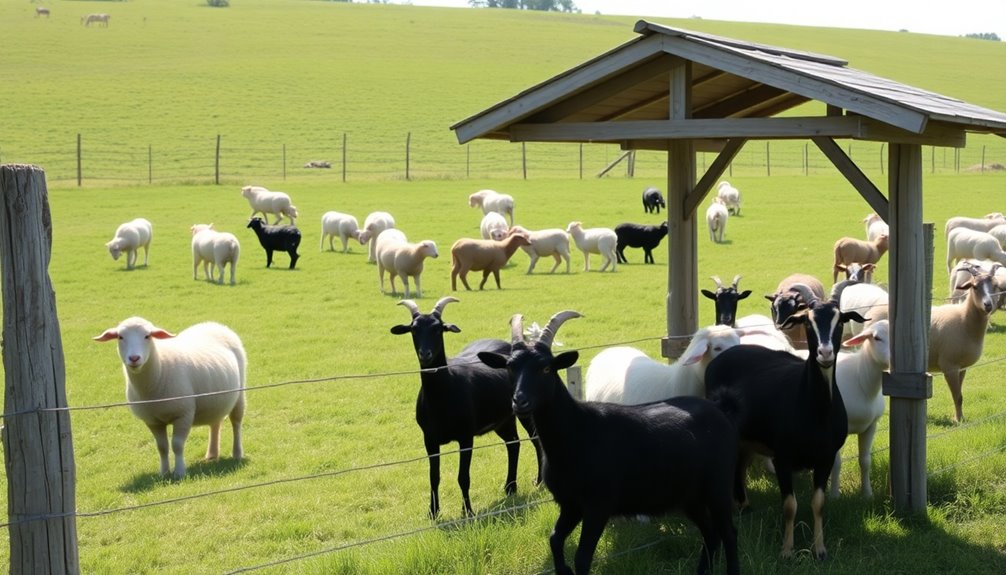
For a mixed herd of sheep and goats, sturdy fencing is essential to guarantee the safety and well-being of both species. Goats are notorious for testing and challenging fences, so effective fencing should be well-maintained and robust enough to contain them.
Consider using woven wire or stock fencing complemented by barbed wire at the top for added security.
In addition to fencing, you need to provide separate shelter areas for sheep and goats. This will help meet their distinct mineral needs and prevent cross-contamination of dietary supplements. Each species has unique nutritional requirements, so keeping them apart is necessary for their health.
You should also manage pasture space carefully. Dividing grazing areas guarantees that both sheep and goats can thrive without competing for resources.
During lambing season, night pens become essential. Make sure these pens have enough space for feeding and sheltering all animals comfortably, which will reduce stress.
Lastly, when introducing new animals, a quarantine period is recommended. Separate housing helps mitigate health risks and manage nutritional differences, making certain a harmonious environment for your mixed herd.
Managing Mixed Herds Successfully
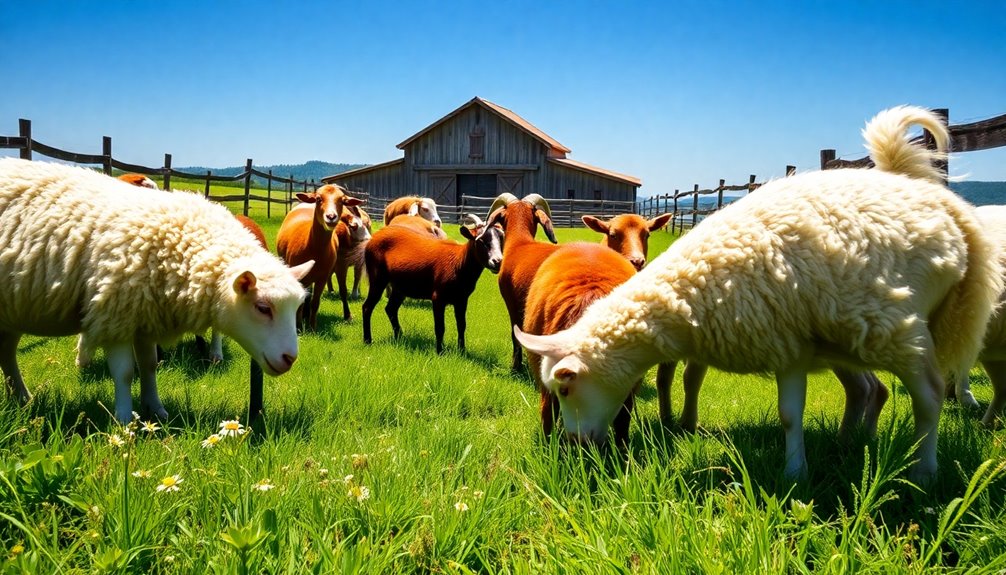
Successful management of mixed herds requires careful attention to the specific needs of both sheep and goats. When you're managing these animals together, consider the following key factors:
- Separate feeding areas: Since sheep are sensitive to copper and goats need higher levels of goat minerals, it's important to provide distinct spaces for feeding.
- Regular health checks: Monitor both species for signs of copper deficiency in goats and make certain routine vaccinations and hoof care are performed.
- Gradual introductions: If you're bringing new animals into the herd, quarantine them first to prevent disease. Gradually introducing them can help reduce stress and aggression.
Additionally, effective fencing is vital to keep your adventurous goats from escaping, while observing behavioral dynamics will help you manage interactions.
Understanding social hierarchies and potential rough play, especially among rams, can prevent conflicts. By focusing on these strategies, you can promote a harmonious environment for your mixed herd, guaranteeing both species thrive together.
Practical Feeding Strategies
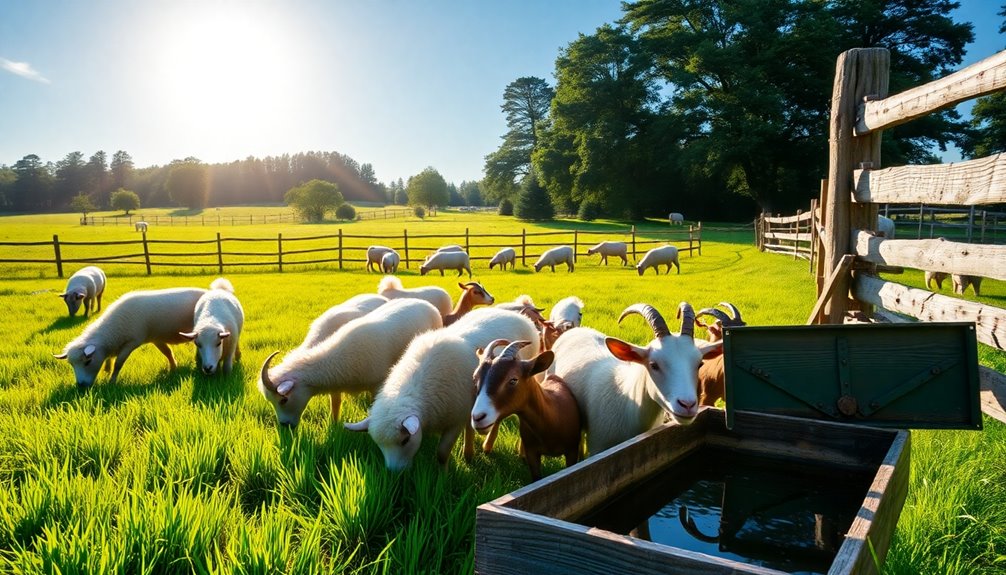
When managing a mixed herd of sheep and goats, creating effective feeding strategies is essential for their health and well-being. Since goats require higher copper levels than sheep, it's important to provide species-specific mineral supplements. This means using a copper bolus for goats while ensuring sheep have access to appropriate sheep mineral.
To optimize feeding, separate feeding areas are necessary. This prevents sheep from consuming goat minerals, which can lead to serious health issues. Goats thrive on browsing shrubs and woody plants, so incorporate elevated feeding systems that keep their hay clean and reduce ground contamination.
In contrast, sheep can be fed at ground level, where they can graze on grass.
Regularly monitor the dietary needs of both species, especially during important life stages like pregnancy and lactation. Adjust your feeding strategies accordingly to maintain their health.
Community Engagement and Support Options
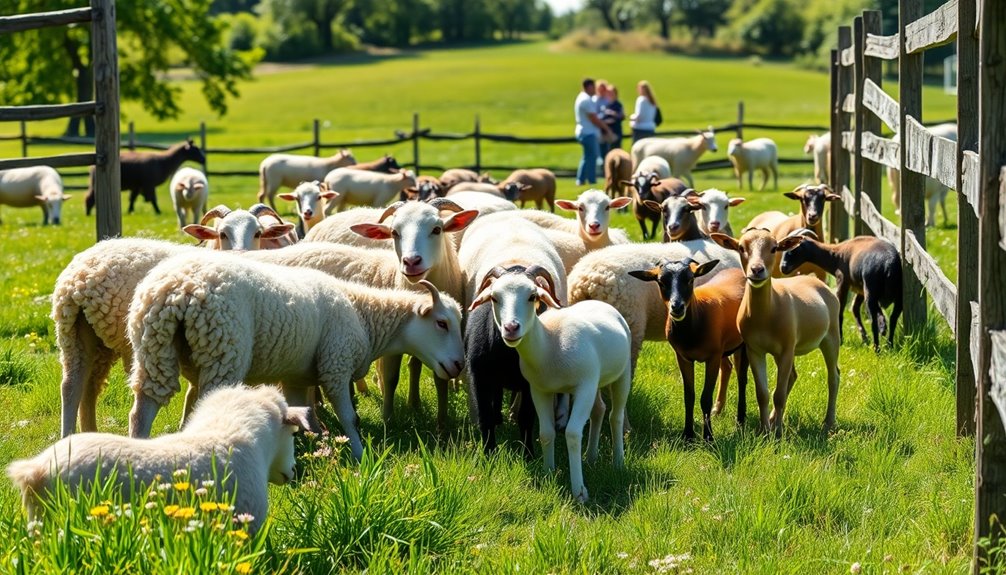
Engaging with your community can greatly enhance your understanding and management of mixed herds of sheep and goats. By connecting with fellow goat owners and sheep enthusiasts, you'll gain invaluable insights into effective herding practices and the welfare of your animals.
Here are some great ways to get involved:
- Attend workshops and training sessions focused on mixed herding techniques.
- Join online forums and social media groups where you can share experiences and advice.
- Volunteer at local sanctuaries that promote sheep welfare and educate the community.
Local organizations often collaborate with sanctuaries to raise awareness and foster community support for sheep and goat welfare. Participating in fundraising events can also help sustain these sanctuaries, ensuring they can continue their essential work.
Not only will you learn more about the needs and behaviors of mixed herds, but you'll also contribute to a larger movement focused on animal welfare.
Frequently Asked Questions
Can Sheep and Goats Be Housed Together?
Yes, you can house sheep and goats together, but it requires careful planning.
You'll need to manage their diets separately since goats need more copper, which can harm sheep. Regular health checks are essential to monitor diseases and guarantee both species thrive.
Observe their behavior closely, as goats can be more energetic and adventurous. Providing adequate space and secure fencing can help prevent any conflicts or escape attempts from your mixed herd.
Why Do Sheep Have to Be Separated From Goats?
Imagine a peaceful meadow where sheep graze quietly, but goats, with their energetic spirit, can disrupt that calm.
You've got to separate them because sheep are more sensitive and might struggle under the goats' assertive nature.
Plus, their different dietary needs can cause health issues; too much copper for sheep can be toxic.
Keeping them apart helps reduce stress and prevents the spread of diseases, ensuring a happier, healthier environment for both species.
What Animals Can You Keep With Sheep?
You can keep several animals with sheep, such as cattle, llamas, and alpacas.
These companions offer protection and don't usually compete for resources.
Poultry, like chickens, can also coexist well with sheep, providing pest control without significant food competition.
Just remember, when introducing new animals, it's wise to quarantine them first to prevent disease and assess compatibility.
Always monitor their interactions, as individual personalities can affect how well they get along.
What Animals Can Be Kept With Goats?
You might think goats can only thrive alone, but that's not true! Goats can happily coexist with various animals.
Consider keeping them with sheep, cows, llamas, or donkeys, as they typically get along well. Chickens and ducks can also share the space, enjoying similar grazing habits.
Just remember to design appropriate fencing and shelter to accommodate their different behaviors, and always keep an eye on their health to guarantee everyone stays happy and safe.
Conclusion
So, if you think keeping sheep and goats together is like hosting a dinner party where everyone's on their best behavior, think again! These two might just turn your farm into a reality show. With a little planning and a solid understanding of their quirks, you can create a mixed herd that thrives—unless, of course, you enjoy midnight fencing repairs and surprise confrontations. Embrace the chaos, and remember: it's not a farm; it's an adventure!

